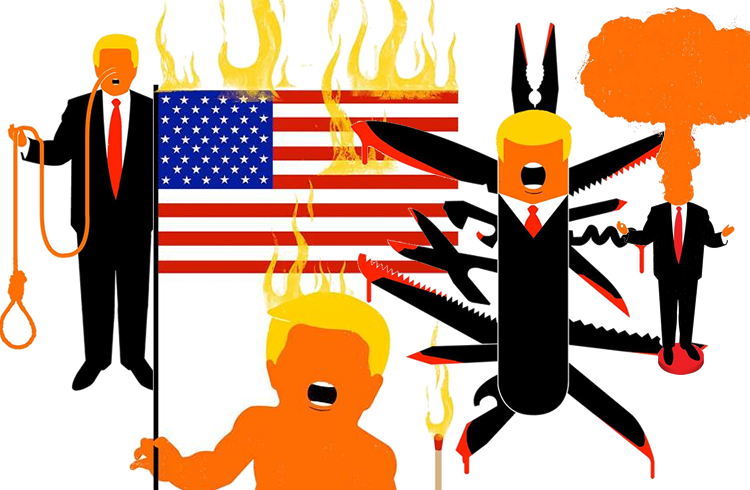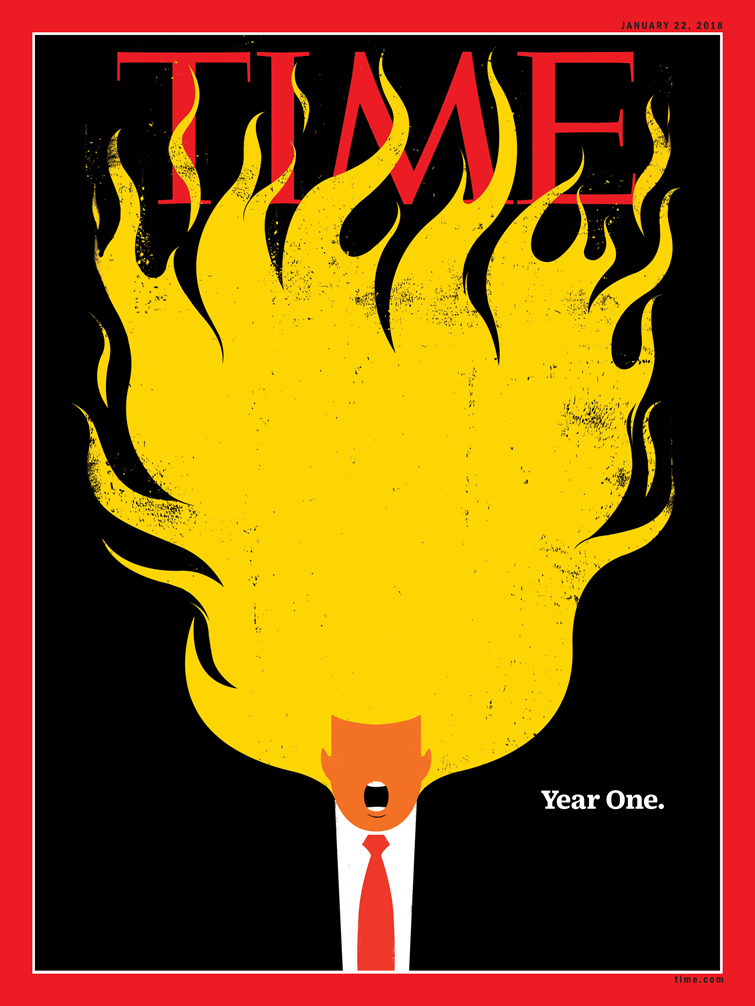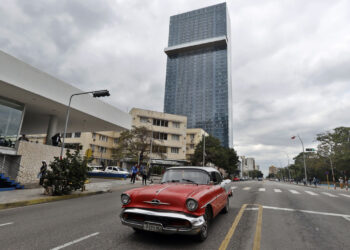“When I think of Donald Trump, a flame, an orange circle, with a hole in the center…as if it were a mouth, immediately comes to my mind. Some images are very powerful,” said the Cuban designer Edel Rodríguez.
Edel Rodríguez (a Cuban American who resides in New York) has made of the U.S. president many illustrations. He started drawing when Trump was running in his presidential campaign, in 2016.
They have always been disquieting images. The first to create a big stir was the cover of the German magazine Der Spiegel (April 2017). Edel drew Donald Trump with a bloodied knife in his left hand and the head of the Statue of Liberty, bleeding, in his right hand. Before this he had even won prizes for a cover of Time magazine, in which Trump was a melted puddle.
You have said that your condition of a Latino, of a Cuban American, somehow marks your work, why?
All my memories, my experiences, were created in Cuba and in Miami. The music, the food, the family, that is my life. And when I paint, that’s what I have in mind.
……………
It was 1993. A young Edel Rodríguez left the city of Miami to go to New York, his mother wasn’t even able to accompany him to the airport; they have been a united family that had gotten around the obstacles of being an émigré, and seeing him leave was heartrending, even though she knew he was going in search of his dreams. Edel gave up a complete grant in the University of Miami (anyone who studies in the United States knows what that means) to accept a partial in the Pratt Institute, because it had an art program that was close to his dreams.

Only a few years ago he was an inquisitive boy who was bewitched with posters and publicity adverts and who followed his father to the dark room where he developed his amateur photos as well as to the truck he drove. He would spend hours sitting by his side, enduring the asphyxiating heat and attentive to his father’s constant insistence: “you have to study.”
His determination took him to the Pratt Institute. In second year he won a complete grant and, before he had concluded his studies he was already working as a designer in Time magazine. It’s impressive to imagine this. A young Cuban American, who had lived since he was eight in Miami, the son of émigrés who worked hard, walking through the corridors of Time, designing and handing over illustrations so that they would take him into account. In 1995 he did his first cover for Time, and at 26 he became the youngest Art Director of that prestigious magazine. He worked there for 13 years.
You were first a designer and later the Art Director of Time magazine, what is the difference? Tell me about the pace of work and the possible margins of creativity.
As a designer you are in charge of the entire magazine, you almost never paint. You’re in search of other artists to make the cover, photographers for the inside feature articles, etc. If I drew it was at night, when I got home. Now I devote myself completely to drawing and painting, and that has helped me concentrate more on the direct form of my drawings.
Your work has been on the cover of some of the world’s most important magazines, how is that process of synthesis of an idea taken to an illustration? Are you given guidelines, or just a general idea that you recreate? How is the process?
Sometimes I have ideas and I send them to the magazines. At other times I am called with an order, with a special report. I read that report and squeeze it to get out the juice, to get out of it the essential. Based on that I start drawing. From the first drawings to the final art, I take one or two days. At times they give me more time, but normally it’s just a few days,
………………
Edel is now an independent designer and artist, he chooses his works, and he can dedicate more time to painting and sculpture, although he doesn’t abandon design. He likes the drawings for magazines because of their immediacy, and the posters for their size. He doesn’t like to make plans, he prefers to work and let things flow. His favorite artists include Picasso, Matisse and Paul Klee; he loves Cuban music, New York salsa, rock, cumbia. He greatly enjoys Spanish and Cuban food and in general that of all of Latin America. He tells he has no time to follow sports, but every four years he makes time for the World Football Cup.
You live in NY, the world’s most cosmopolitan city, what distinguishes those who emigrate? Is multiculturalism a source of creativity for you?
Many of those who come to New York are artists, musicians and writers, people with big dreams. Here there’s a public that appreciates the artists, go to their functions, helps them. New York has a cultural history and so many museums, all that has an influence on an artist. There are exhibitions, music and dance almost every night; I’m frequently in those places. It’s a city with a lot of life.
Do you believe there’s a limit between Art and Design?
Yes, design has to communicate something. You almost always have clients, others’ opinions, etc. Art doesn’t have to communicate so directly and doesn’t have the limits clients impose, the size, etc. For me they are different things that at times come together, as a creator I enjoy thinking in several ways.

…………..
Between April and October 1980 around 125,000 Cubans left through the port of Mariel for the United States, in what was known as the Mariel exodus. Edel and his family arrived in Key West on a boat, in the midst of the apotheosis that that journey must have been for an eight-year-old boy.
Edel has repeated in many interviews that his condition of immigrant made him react to President Trump’s announced anti-immigration policy. “I don’t agree with any dictator,” I heard him say in an interview for Univisión, and “for me, an émigré, it is an insult, that’s why I came up with the idea that [Trump] was cutting off emigration’s head, democracy’s head.”1
The covers you have done related to Trump have surely been the ones that have had the most repercussion of your work, what has been the motivation? Is that the impact you were expecting?
I wanted the public to see the danger we were running with this president. He is a person who exhibits the ideas of a dictator. The covers have had much more impact than I could have expected. I believe the public is hungry for something like that, strong and direct opinions on a character that deserves them.
As an immigrant one feels one is here and there. I feel I belong to any place in the world where there are people who want to talk, dance and enjoy love and friendship.
…………
Edel Rodríguez (Havana, Cuba, 1971). Cuban-American designer, illustrator and visual artist. His work has been exhibited in Los Angeles, Toronto, New York, Dallas, Philadelphia, Cuba, Spain, among other countries.
In 1994 he graduated with honors from New York’s Pratt Institute. In 1998 he got his Master of Fine Arts degree in painting from Manhattan’s Hunter College graduate program. He has worked for prestigious publications, among them: The New York Times, Time, The New Yorker and Newsweek magazines. He has designed numerous posters and illustrations and book covers. He is the author of Sergio Makes a Splash. Rodríguez’ work forms part of private and corporative collections, among them the Smithsonian Institute in Washington DC.
1 Interview on Univisión’s program Al punto. Published on February 12, 2017.












